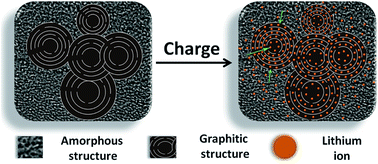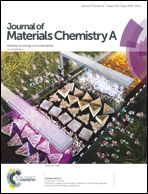Graphitic carbon balanced between high plateau capacity and high rate capability for lithium ion capacitors†
Abstract
Graphitic carbon (GC) derived from sisal fibers is prepared through pre-carbonization and catalytic graphitization at low temperature (<1200 °C). The plateau capacity is regulated by the ordered degree of GC. The as-prepared GC1100 at 1100 °C possesses a high plateau capacity of 243 mA h g−1 below 0.2 V representing 68% of the total reversible capacity of 354 mA h g−1 at 0.05 A g−1, high rate capability (222 mA h g−1 at 1 A g−1) and excellent cycling stability. The superior electrochemical performance is ascribed to the coexistence of graphitic structure and amorphous structure. The graphitic structure contributes to high plateau capacity and electrical conductivity, and the amorphous structure supplies a more convenient pathway for Li+ ions and protects the graphitic structure from the etching of the electrolyte. Additionally, a lithium ion capacitor (LIC) is assembled with sisal fiber activated carbon (SFAC-2) as the positive electrode and GC1100 as the negative electrode. The LIC displays high energy densities of 104 and 32 W h kg−1 obtained at 143 and 6628 W kg−1, respectively, and outstanding cycling stability with the energy density retention of 94.7% at 0.5 A g−1 and 96.5% at 1 A g−1 after 3000 cycles.



 Please wait while we load your content...
Please wait while we load your content...